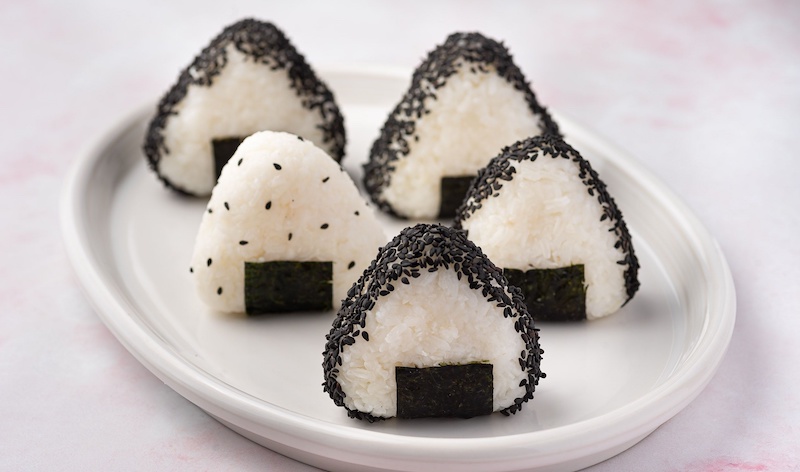
At every convenience store (konbini) in Japan (or a Japanese market in America), you will find a decent selection of handy, delightful treasures called onigiri — rice balls.
They are neat, easy to eat, and perhaps the most snackable of all Japanese snacks; ergo, their perfect fit for a konbini and a quick bite. They’re so small and cute that people actually have an affection for them and consider them “happy” snacks! In fact, besides bento boxes, onigiri are some of the most popular spring picnic items brought to Tokyo’s Ueno Park during cherry blossom (sakura) season.
A basic onigiri begins with white rice (though not seasoned with rice vinegar like sushi rice), combined with sprinkled seasonings, such as furikake and black sesame seeds. Often the rice is stuffed with anything from teriyaki chicken to salmon to pickled veggies. Sometimes, the rice balls are wrapped in nori, seaweed sheets. All of this deliciousness is shaped into triangles (most common) and squares, usually measuring no more than three to four inches wide.
A go-to for breakfast and lunch in Japanese households, onigiri is kid-friendly and busy-adult friendly, with recipes and variations that are plentiful. Think of it this way: if you can put anything in a sandwich, you can get really creative with onigiri. There’s no “right” filling.
In honor of Asian Pacific Islander Heritage Month, here’s a basic onigiri recipe and some classic filling options that are sure to make you and your whole family onigiri-snack-happy.
Makes 4
Prep time: 20 Minutes
(Recipe by Christine Chen, Chief Editor, The Journal)

“Remembering to be as self compassionate as I can and praying to the divine that we're all a part of.”
–Aaron
“Prayer, reading, meditation, walking.”
–Karen
“Erratically — which is an ongoing stream of practice to find peace.”
–Charles
“Try on a daily basis to be kind to myself and to realize that making mistakes is a part of the human condition. Learning from our mistakes is a journey. But it starts with compassion and caring. First for oneself.”
–Steve
“Physically: aerobic exercise, volleyball, ice hockey, cycling, sailing. Emotionally: unfortunately I have to work to ‘not care’ about people or situations which may end painfully. Along the lines of ‘attachment is the source of suffering’, so best to avoid it or limit its scope. Sad though because it could also be the source of great joy. Is it worth the risk?“
–Rainer


“It's time for my heart to be nurtured on one level yet contained on another. To go easy on me and to allow my feelings to be validated, not judged harshly. On the other hand, to let the heart rule with equanimity and not lead the mind and body around like a master.”
–Suzanne
“I spend time thinking of everything I am grateful for, and I try to develop my ability to express compassion for myself and others without reservation. I take time to do the things I need to do to keep myself healthy and happy. This includes taking experiential workshops, fostering relationships, and participating within groups which have a similar interest to become a more compassionate and fulfilled being.“
–Peter


“Self-forgiveness for my own judgments. And oh yeah, coming to Esalen.”
–David B.
“Hmm, this is a tough one! I guess I take care of my heart through fostering relationships with people I feel connected to. Spending quality time with them (whether we're on the phone, through messages/letters, on Zoom, or in-person). Being there for them, listening to them, sharing what's going on with me, my struggles and my successes... like we do in the Esalen weekly Friends of Esalen Zoom sessions!”
–Lori

“I remind myself in many ways of the fact that " Love is all there is!" LOVE is the prize and this one precious life is the stage we get to learn our lessons. I get out into nature, hike, camp, river kayak, fly fish, garden, I create, I dance (not enough!), and I remain grateful for each day, each breath, each moment. Being in the moment, awake, and remembering the gift of life and my feeling of gratitude for all of creation.”
–Steven
“My physical heart by limiting stress and eating a heart-healthy diet. My emotional heart by staying in love with the world and by knowing that all disappointment and loss will pass.“
–David Z.
Today, September 29, is World Heart Day. Strike up a conversation with your own heart and as you feel comfortable, encourage others to do the same. As part of our own transformations and self-care, we sometimes ask for others to illuminate and enliven our hearts or speak our love language.
What if we could do this for ourselves too, even if just for today… or to start a heart practice, forever?

At every convenience store (konbini) in Japan (or a Japanese market in America), you will find a decent selection of handy, delightful treasures called onigiri — rice balls.
They are neat, easy to eat, and perhaps the most snackable of all Japanese snacks; ergo, their perfect fit for a konbini and a quick bite. They’re so small and cute that people actually have an affection for them and consider them “happy” snacks! In fact, besides bento boxes, onigiri are some of the most popular spring picnic items brought to Tokyo’s Ueno Park during cherry blossom (sakura) season.
A basic onigiri begins with white rice (though not seasoned with rice vinegar like sushi rice), combined with sprinkled seasonings, such as furikake and black sesame seeds. Often the rice is stuffed with anything from teriyaki chicken to salmon to pickled veggies. Sometimes, the rice balls are wrapped in nori, seaweed sheets. All of this deliciousness is shaped into triangles (most common) and squares, usually measuring no more than three to four inches wide.
A go-to for breakfast and lunch in Japanese households, onigiri is kid-friendly and busy-adult friendly, with recipes and variations that are plentiful. Think of it this way: if you can put anything in a sandwich, you can get really creative with onigiri. There’s no “right” filling.
In honor of Asian Pacific Islander Heritage Month, here’s a basic onigiri recipe and some classic filling options that are sure to make you and your whole family onigiri-snack-happy.
Makes 4
Prep time: 20 Minutes
(Recipe by Christine Chen, Chief Editor, The Journal)

“Remembering to be as self compassionate as I can and praying to the divine that we're all a part of.”
–Aaron
“Prayer, reading, meditation, walking.”
–Karen
“Erratically — which is an ongoing stream of practice to find peace.”
–Charles
“Try on a daily basis to be kind to myself and to realize that making mistakes is a part of the human condition. Learning from our mistakes is a journey. But it starts with compassion and caring. First for oneself.”
–Steve
“Physically: aerobic exercise, volleyball, ice hockey, cycling, sailing. Emotionally: unfortunately I have to work to ‘not care’ about people or situations which may end painfully. Along the lines of ‘attachment is the source of suffering’, so best to avoid it or limit its scope. Sad though because it could also be the source of great joy. Is it worth the risk?“
–Rainer


“It's time for my heart to be nurtured on one level yet contained on another. To go easy on me and to allow my feelings to be validated, not judged harshly. On the other hand, to let the heart rule with equanimity and not lead the mind and body around like a master.”
–Suzanne
“I spend time thinking of everything I am grateful for, and I try to develop my ability to express compassion for myself and others without reservation. I take time to do the things I need to do to keep myself healthy and happy. This includes taking experiential workshops, fostering relationships, and participating within groups which have a similar interest to become a more compassionate and fulfilled being.“
–Peter


“Self-forgiveness for my own judgments. And oh yeah, coming to Esalen.”
–David B.
“Hmm, this is a tough one! I guess I take care of my heart through fostering relationships with people I feel connected to. Spending quality time with them (whether we're on the phone, through messages/letters, on Zoom, or in-person). Being there for them, listening to them, sharing what's going on with me, my struggles and my successes... like we do in the Esalen weekly Friends of Esalen Zoom sessions!”
–Lori

“I remind myself in many ways of the fact that " Love is all there is!" LOVE is the prize and this one precious life is the stage we get to learn our lessons. I get out into nature, hike, camp, river kayak, fly fish, garden, I create, I dance (not enough!), and I remain grateful for each day, each breath, each moment. Being in the moment, awake, and remembering the gift of life and my feeling of gratitude for all of creation.”
–Steven
“My physical heart by limiting stress and eating a heart-healthy diet. My emotional heart by staying in love with the world and by knowing that all disappointment and loss will pass.“
–David Z.
Today, September 29, is World Heart Day. Strike up a conversation with your own heart and as you feel comfortable, encourage others to do the same. As part of our own transformations and self-care, we sometimes ask for others to illuminate and enliven our hearts or speak our love language.
What if we could do this for ourselves too, even if just for today… or to start a heart practice, forever?

At every convenience store (konbini) in Japan (or a Japanese market in America), you will find a decent selection of handy, delightful treasures called onigiri — rice balls.
They are neat, easy to eat, and perhaps the most snackable of all Japanese snacks; ergo, their perfect fit for a konbini and a quick bite. They’re so small and cute that people actually have an affection for them and consider them “happy” snacks! In fact, besides bento boxes, onigiri are some of the most popular spring picnic items brought to Tokyo’s Ueno Park during cherry blossom (sakura) season.
A basic onigiri begins with white rice (though not seasoned with rice vinegar like sushi rice), combined with sprinkled seasonings, such as furikake and black sesame seeds. Often the rice is stuffed with anything from teriyaki chicken to salmon to pickled veggies. Sometimes, the rice balls are wrapped in nori, seaweed sheets. All of this deliciousness is shaped into triangles (most common) and squares, usually measuring no more than three to four inches wide.
A go-to for breakfast and lunch in Japanese households, onigiri is kid-friendly and busy-adult friendly, with recipes and variations that are plentiful. Think of it this way: if you can put anything in a sandwich, you can get really creative with onigiri. There’s no “right” filling.
In honor of Asian Pacific Islander Heritage Month, here’s a basic onigiri recipe and some classic filling options that are sure to make you and your whole family onigiri-snack-happy.
Makes 4
Prep time: 20 Minutes
(Recipe by Christine Chen, Chief Editor, The Journal)

“Remembering to be as self compassionate as I can and praying to the divine that we're all a part of.”
–Aaron
“Prayer, reading, meditation, walking.”
–Karen
“Erratically — which is an ongoing stream of practice to find peace.”
–Charles
“Try on a daily basis to be kind to myself and to realize that making mistakes is a part of the human condition. Learning from our mistakes is a journey. But it starts with compassion and caring. First for oneself.”
–Steve
“Physically: aerobic exercise, volleyball, ice hockey, cycling, sailing. Emotionally: unfortunately I have to work to ‘not care’ about people or situations which may end painfully. Along the lines of ‘attachment is the source of suffering’, so best to avoid it or limit its scope. Sad though because it could also be the source of great joy. Is it worth the risk?“
–Rainer


“It's time for my heart to be nurtured on one level yet contained on another. To go easy on me and to allow my feelings to be validated, not judged harshly. On the other hand, to let the heart rule with equanimity and not lead the mind and body around like a master.”
–Suzanne
“I spend time thinking of everything I am grateful for, and I try to develop my ability to express compassion for myself and others without reservation. I take time to do the things I need to do to keep myself healthy and happy. This includes taking experiential workshops, fostering relationships, and participating within groups which have a similar interest to become a more compassionate and fulfilled being.“
–Peter


“Self-forgiveness for my own judgments. And oh yeah, coming to Esalen.”
–David B.
“Hmm, this is a tough one! I guess I take care of my heart through fostering relationships with people I feel connected to. Spending quality time with them (whether we're on the phone, through messages/letters, on Zoom, or in-person). Being there for them, listening to them, sharing what's going on with me, my struggles and my successes... like we do in the Esalen weekly Friends of Esalen Zoom sessions!”
–Lori

“I remind myself in many ways of the fact that " Love is all there is!" LOVE is the prize and this one precious life is the stage we get to learn our lessons. I get out into nature, hike, camp, river kayak, fly fish, garden, I create, I dance (not enough!), and I remain grateful for each day, each breath, each moment. Being in the moment, awake, and remembering the gift of life and my feeling of gratitude for all of creation.”
–Steven
“My physical heart by limiting stress and eating a heart-healthy diet. My emotional heart by staying in love with the world and by knowing that all disappointment and loss will pass.“
–David Z.
Today, September 29, is World Heart Day. Strike up a conversation with your own heart and as you feel comfortable, encourage others to do the same. As part of our own transformations and self-care, we sometimes ask for others to illuminate and enliven our hearts or speak our love language.
What if we could do this for ourselves too, even if just for today… or to start a heart practice, forever?